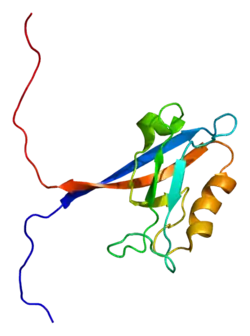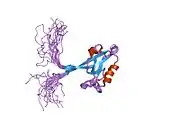Tight junction protein 2
Tight junction protein ZO-2 is a protein that in humans is encoded by the TJP2 gene.[5]
Tight junction proteins (TJPs) belong to a family of membrane-associated guanylate kinase (MAGUK) homologs that are involved in the organization of epithelial and endothelial intercellular junctions. TJPs bind to the cytoplasmic C termini of junctional transmembrane proteins and link them to the actin cytoskeleton [supplied by OMIM].[6]
Interactions
Tight junction protein 2 has been shown to interact with tight junction protein 1,[7][8][9] band 4.1,[10] occludin[7][8][11] and USP53.[12]
References
- GRCh38: Ensembl release 89: ENSG00000119139 - Ensembl, May 2017
- GRCm38: Ensembl release 89: ENSMUSG00000024812 - Ensembl, May 2017
- "Human PubMed Reference:". National Center for Biotechnology Information, U.S. National Library of Medicine.
- "Mouse PubMed Reference:". National Center for Biotechnology Information, U.S. National Library of Medicine.
- Duclos F, Rodius F, Wrogemann K, Mandel JL, Koenig M (November 1994). "The Friedreich ataxia region: characterization of two novel genes and reduction of the critical region to 300 kb". Hum Mol Genet. 3 (6): 909–914. doi:10.1093/hmg/3.6.909. PMID 7951235.
- "Entrez Gene: TJP2 tight junction protein 2 (zona occludens 2)".
- Itoh, M; Morita K; Tsukita S (February 1999). "Characterization of ZO-2 as a MAGUK family member associated with tight as well as adherens junctions with a binding affinity to occludin and alpha catenin". J. Biol. Chem. 274 (9): 5981–5986. doi:10.1074/jbc.274.9.5981. ISSN 0021-9258. PMID 10026224.
- Wittchen, E S; Haskins J; Stevenson B R (December 1999). "Protein interactions at the tight junction. Actin has multiple binding partners, and ZO-1 forms independent complexes with ZO-2 and ZO-3". J. Biol. Chem. 274 (49): 35179–35185. doi:10.1074/jbc.274.49.35179. ISSN 0021-9258. PMID 10575001.
- Fanning, A S; Jameson B J; Jesaitis L A; Anderson J M (November 1998). "The tight junction protein ZO-1 establishes a link between the transmembrane protein occludin and the actin cytoskeleton". J. Biol. Chem. 273 (45): 29745–29753. doi:10.1074/jbc.273.45.29745. ISSN 0021-9258. PMID 9792688.
- Mattagajasingh, S N; Huang S C; Hartenstein J S; Benz E J (September 2000). "Characterization of the interaction between protein 4.1R and ZO-2. A possible link between the tight junction and the actin cytoskeleton". J. Biol. Chem. 275 (39): 30573–30585. doi:10.1074/jbc.M004578200. ISSN 0021-9258. PMID 10874042.
- Peng, Bi-Hung; Lee J Ching; Campbell Gerald A (December 2003). "In vitro protein complex formation with cytoskeleton-anchoring domain of occludin identified by limited proteolysis". J. Biol. Chem. 278 (49): 49644–49651. doi:10.1074/jbc.M302782200. ISSN 0021-9258. PMID 14512431.
- Kazmierczak M, Harris SL, Kazmierczak P, Shah P, Starovoytov V, Ohlemiller KK, Schwander M (November 2015). "Progressive Hearing Loss in Mice Carrying a Mutation in Usp53". The Journal of Neuroscience. 35 (47): 15582–98. doi:10.1523/JNEUROSCI.1965-15.2015. PMC 4659823. PMID 26609154.
Further reading
- Denker BM, Nigam SK (1998). "Molecular structure and assembly of the tight junction". Am. J. Physiol. 274 (1 Pt 2): F1–9. doi:10.1152/ajprenal.1998.274.1.F1. PMID 9458817.
- González-Mariscal L, Betanzos A, Avila-Flores A (2000). "MAGUK proteins: structure and role in the tight junction". Semin. Cell Dev. Biol. 11 (4): 315–324. doi:10.1006/scdb.2000.0178. PMID 10966866.
- King JE, Eugenin EA, Buckner CM, Berman JW (2006). "HIV tat and neurotoxicity". Microbes Infect. 8 (5): 1347–1357. doi:10.1016/j.micinf.2005.11.014. PMID 16697675.
- Van Itallie CM, Balda MS, Anderson JM (1995). "Epidermal growth factor induces tyrosine phosphorylation and reorganization of the tight junction protein ZO-1 in A431 cells". J. Cell Sci. 108 (4): 1735–42. PMID 7542259.
- Beatch M, Jesaitis LA, Gallin WJ, et al. (1996). "The tight junction protein ZO-2 contains three PDZ (PSD-95/Discs-Large/ZO-1) domains and an alternatively spliced region". J. Biol. Chem. 271 (42): 25723–25726. doi:10.1074/jbc.271.42.25723. PMID 8824195.
- Itoh M, Morita K, Tsukita S (1999). "Characterization of ZO-2 as a MAGUK family member associated with tight as well as adherens junctions with a binding affinity to occludin and alpha catenin". J. Biol. Chem. 274 (9): 5981–5986. doi:10.1074/jbc.274.9.5981. PMID 10026224.
- Chlenski A, Ketels KV, Tsao MS, et al. (1999). "Tight junction protein ZO-2 is differentially expressed in normal pancreatic ducts compared to human pancreatic adenocarcinoma". Int. J. Cancer. 82 (1): 137–144. doi:10.1002/(SICI)1097-0215(19990702)82:1<137::AID-IJC23>3.0.CO;2-F. PMID 10360833.
- Chlenski A, Ketels KV, Engeriser JL, et al. (1999). "zo-2 gene alternative promoters in normal and neoplastic human pancreatic duct cells". Int. J. Cancer. 83 (3): 349–358. doi:10.1002/(SICI)1097-0215(19991029)83:3<349::AID-IJC10>3.0.CO;2-C. PMID 10495427.
- Wittchen ES, Haskins J, Stevenson BR (2000). "Protein interactions at the tight junction. Actin has multiple binding partners, and ZO-1 forms independent complexes with ZO-2 and ZO-3". J. Biol. Chem. 274 (49): 35179–35185. doi:10.1074/jbc.274.49.35179. PMID 10575001.
- Itoh M, Furuse M, Morita K, et al. (2000). "Direct binding of three tight junction-associated MAGUKs, ZO-1, ZO-2, and ZO-3, with the COOH termini of claudins". J. Cell Biol. 147 (6): 1351–1363. doi:10.1083/jcb.147.6.1351. PMC 2168087. PMID 10601346.
- Cordenonsi M, D'Atri F, Hammar E, et al. (2000). "Cingulin contains globular and coiled-coil domains and interacts with ZO-1, ZO-2, ZO-3, and myosin". J. Cell Biol. 147 (7): 1569–1582. doi:10.1083/jcb.147.7.1569. PMC 2174252. PMID 10613913.
- Mattagajasingh SN, Huang SC, Hartenstein JS, Benz EJ (2000). "Characterization of the interaction between protein 4.1R and ZO-2. A possible link between the tight junction and the actin cytoskeleton". J. Biol. Chem. 275 (39): 30573–30585. doi:10.1074/jbc.M004578200. PMID 10874042.
- Chlenski A, Ketels KV, Korovaitseva GI, et al. (2000). "Organization and expression of the human zo-2 gene (tjp-2) in normal and neoplastic tissues". Biochim. Biophys. Acta. 1493 (3): 319–24. doi:10.1016/S0167-4781(00)00185-8. PMID 11018256.
- Citi S, D'Atri F, Parry DA (2000). "Human and Xenopus cingulin share a modular organization of the coiled-coil rod domain: predictions for intra- and intermolecular assembly". J. Struct. Biol. 131 (2): 135–145. doi:10.1006/jsbi.2000.4284. PMID 11042084.
- Hartley JL, Temple GF, Brasch MA (2001). "DNA cloning using in vitro site-specific recombination". Genome Res. 10 (11): 1788–1795. doi:10.1101/gr.143000. PMC 310948. PMID 11076863.
- Glaunsinger BA, Weiss RS, Lee SS, Javier R (2001). "Link of the unique oncogenic properties of adenovirus type 9 E4-ORF1 to a select interaction with the candidate tumor suppressor protein ZO-2". EMBO J. 20 (20): 5578–5586. doi:10.1093/emboj/20.20.5578. PMC 125668. PMID 11598001.
- Islas S, Vega J, Ponce L, González-Mariscal L (2002). "Nuclear localization of the tight junction protein ZO-2 in epithelial cells". Exp. Cell Res. 274 (1): 138–148. doi:10.1006/excr.2001.5457. PMID 11855865.
This article is issued from Wikipedia. The text is licensed under Creative Commons - Attribution - Sharealike. Additional terms may apply for the media files.






